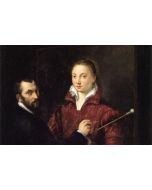Visionary experiments: American art of the 1940s and 50s
- Course Code: VB669
- Dates: 26/04/24 - 24/05/24
- Time: 13:30 - 15:30
- Taught: Fri, Daytime
- Duration: 5 sessions (over 5 weeks)
- Location: Keeley Street
- Tutor: Sarah Jaffray
Course Code: VB669
Duration: 5 sessions (over 5 weeks)
Please note: We offer a wide variety of financial support to make courses affordable. Just visit our online Help Centre for more information on a range of topics including fees, online learning and FAQs.
What is the course about?
Post-WWII American has been stereotyped as the land of motor cars and shopping malls, hoop skirts and housewives. However, there was thriving counter-culture, led by the socialism of the 1930s, burgeoning civil rights movements and refugees from war-torn Europe. Art was at the centre of these circumstances.
This course begins with a discussion of Black Mountain College, the Bauhaus-modelled school with faculty that featured some of the most innovative minds of the 20th century, including Anni and Josef Albers, R. Buckminster Fuller and John Cage. We then move into the use of art in social justice and civil rights movements that grew out of the Harlem Renaissance of the 1920s and 30s as well as the increase of photojournalism in the 1930s. We look at the New York School (Abstract Expressionism) and Neo-Dada and how they emerged out of the practice of exiled European artists and thinkers including Hans Hofman, Marcel Duchamp and Piet Mondrian.
The goal of this course is to create a foundation to some of the theories and practices we find in late modernist and contemporary art. We go beyond Jackson Pollock to better understand the significance, achievements and influence of the artists and art of America at this time.
The course will look at the work of Ruth Asawa, Lee Krasner, Jacob Lawrence, Mark Rothko, Robert Rauschenberg, Mary Parks Washington, Robert Motherwell, Elizabeth Catlett, Dorothea Lange and Robert Frank among others.
What will we cover?
-The context of the period: influence of exiled European artists, the civil rights movement, counter-culture, changing spirituality and psychology.
-New modes of painting with a focus on abstract expressionism
-New modes of art including performance, collage, 'new media' sculpture
-Art and politics with a focus on social realism and photojournalism.
What will I achieve?
By the end of this course you should be able to...
-Discuss the impact of exiled Europeans on the direction of art in 1940s and 50s America
-Explain the work, contect and intention of the art of at least two artists covered in this course
-Demonstrate an understanding of at least one of the key theories or art practices that emerged from this period/place.
What level is the course and do I need any particular skills?
This course is suitable for all levels. However, the course includes optional readings that some learners may find challenging because it uses art terminology and theory.
How will I be taught, and will there be any work outside the class?
You will be taught with a combination of lecture (with powerpoint slides), discussion and group activities. There will be homework. Homework changes each week, but generally takes the form of readings, watching videos or looking at works of art and is designed to take no more than 30 minutes outside of class each week.
You will be asked to join a Google Classroom where documents and course materials will be shared.
Are there any other costs? Is there anything I need to bring?
There are no additional costs. You may wish to purchase a notebook for your course materials.
When I've finished, what course can I do next?
Art in 1920s Paris
Modern Art in America: the Ashcan School to Precisionism
Modern Art in America: the age of Hopper, Rivera and the New Deal
Makers not muses: Claude Cahun, Eileen Agar and Isabel Rawsthorne.
Sarah Jaffray holds a BA and MA in Art History with an emphasis in 19th/20th century France and a minor in the Italian Renaissance. She holds a second MA in Cultural Theory from Goldsmiths, University of London. Sarah was a lecturer for several colleges and universities in the Los Angeles area before relocating to London in 2012. She has worked in curatorial roles at the British Museum and Wellcome Collection. In addition to her current teaching at City Lit, Sarah is a lecturer at the University of Arts London and the Tutor Coordinator for City Lit's Art History programme. Her art historical practice focuses on experimental narratives, artistic process, art pedagogy, politics and philosophy. Sarah's current research is focused on translation and empathy.
Please note: We reserve the right to change our tutors from those advertised. This happens rarely, but if it does, we are unable to refund fees due to this. Our tutors may have different teaching styles; however we guarantee a consistent quality of teaching in all our courses.
